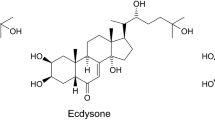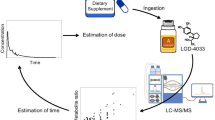Abstract
In this manuscript the chemical and pharmacokinetic evaluation of a doping case associated with the use of an Ephedra-labelled dietary supplement is reported. The urine of a Dutch professional cyclist was found to be positive for norpseudoephedrine at a doping control. An inquiry revealed that the cyclist had consumed a liquid herbal food supplement with Ephedra as one of its 15 declared ingredients. Chemical analysis revealed concentrations of 6.8‐8.2 mg/ml of norpseudoephedrine and 0.02‐0.03 mg/ml of ephedrine in several batches, which could have caused the positive doping test. Since the International Olympic Committee (IOC) list of doping substances comprises several substances which occur naturally in botanicals, doping agents like ephedrines and/or caffeine may be taken unwittingly in the form of herbal food supplements. In this case, the predominance of norpseudoephedrine over ephedrine was explained by spiking with norpseudoephedrine, showing that adulteration of herbal food supplements with undeclared agents also have to be taken into account. Our report demonstrates a need for improved quality control of herbal food supplements.
Similar content being viewed by others
References
Zhang JS, Zhen T, Zhi-cen L. Simultaneous determination of six alkaloids in Ephedrae Herba by high performance liquid chromatography. Planta Med 1988;54:69-70.
Hiller K. Ephedra. In: Hänsel R, Keller K, Rimpler H, Schneider G, eds. Hagers Handbuch der Pharmazeutischen Praxis. 5th edn. Fünfter Band: Drogen E-O. Berlin: Springer-Verlag, 1993:46-57.
Tyler VE. The honest herbal. A sensible guide to the use of herbs and related remedies. 3rd edn. New York: Pharmaceutical Products Press, 1993;119-21:215-6.
Department of Health and Human Services. Unsubstantiated claims and documented health hazards in the dietary supplement marketplace. Rockville: Public Health Service, Food and Drug Administration 1993:101.
Anonymous. Adverse events with Ephedra and other botanical dietary supplements. FDA Med Bull 1994; 24(2):3.
Blumenthal M, King P. Ma Huang: ancient herb, modern medicine, regulatory dilemma. A review of the botany, chemistry, medicinal uses, safety concerns, and legal status of Ephedra and its alkaloids. HerbalGram 1995;34:22-42.
Anonymous. Definition of doping and list of doping classes and methods. International Olympic Committee Medical Commission. Paris, 5 september 1994.
De Smet PAGM. Drugs used in non-orthodox medicine. In: Dukes MNG, Beeley L, eds. Side Effects of Drugs-Annual 14. Amsterdam: Elsevier 1990;429-51.
Kalix P. The pharmacology of psychoactive alkaloids from Ephedra and catha. J Ethnopharmacol 1991;32:201-8.
Widler P, Mathys K, Brenneisen R, Kalix P, Fisch HU. Pharmacodynamics and pharmacokinetics of khat: a controlled study. Clin Pharmacol Ther 1994;55:556-62.
De Smet PAGM. A multidisciplinary overview of intoxicating snuff rituals in the western hemisphere. J Ethnopharmacol 1985;13:3-49.
Siegel RK, Elsohly MA, Plowman T, Rury PM, Jones RT. Cocaine in herbal tea. JAMA 1986;255:40.
Zhang JS, Tian Z, Lou ZC. Quality evaluation of twelve species of Chinese Ephedra (Ma huang). Acta Pharm Sin 1989;24:865-71.
Liu Y-M, Sheu S-J, Chiou S-H, Chang H-C, Chen Y-P. A comparative study on commercial samples of Ephedrae herba. Planta Med 1993;59:376-8.
Hoppe HA. Drogenkunde. Band 1. Angiospermen. 8. Auflage. Berlin: Walter de Gruyter, 1975;785-90:1045-50.
Pelders MG, Ros JJW. Poppy seeds: differences in morphine and codeine content and variation in inter-and intra-individual excretion. Journal of Forensic Sciences 1996;41:209-12.
Anonymous. Het eeuwige gevecht tegen de kilo's. Consumentengids 1995;5:296-300.
De Smet PAGM. Toxicological outlook on the quality assurance of herbal remedies. In: De Smet PAGM, Keller K, Hänsel R, Chandler RF, eds. Adverse effects of herbal drugs. Volume 1. Heidelberg: Springer-Verlag 1992; 1-72.
Cui J, Garle M, Eneroth P, Björkhem I. What do commercial ginseng preparations contain? Lancet 1994;344:134.
Catlin DH, Sekera M, Adelman DC. Erythroderma associated with ingestion of an herbal product. West J Med 1993;159:491-3.
De Smet PAGM, Smeets OSNM. Potential risks of health food products containing yohimbe extracts. Br Med J 1994;309:958.
Van Wissen H. DePerri aangeklaagd wegens 'ondoordacht' dopegebruik. De Volkskrant, 27 april1995:20.
Rights and permissions
About this article
Cite this article
Ros, J.J., Pelders, M.G. & De Smet, P.A. A case of positive doping associated with a botanical food supplement. Pharm World Sci 21, 44–46 (1999). https://doi.org/10.1023/A:1008681612399
Issue Date:
DOI: https://doi.org/10.1023/A:1008681612399




